“He told me his brother Gregorio that in order to pull him along and keep him at painting it set himself to work for shopkeepers, who were then rich and made work, whereupon he worked for the coloraro Nasini alla Sapienza; which by the way the things of the first manner were beautiful and firm but there are few of them.” The author of the passage just quoted is the collector Sebastiano Resta (Milan, 1635 - Rome, 1714), the protagonist of the story is Gregorio Preti (Taverna, 1603 - Rome, 1672), and the boy who is initiated by the latter into painting is his brother Mattia (Taverna, 1613 - Valletta, 1699), destined to become one of the greatest artists of the seventeenth century. Extremely interesting is the case of these two brothers who came to Rome at a very young age from the deep South, from the distant province, from the mountains of Calabria: according to documents discovered some fifteen years ago by Rossella Vodret, Gregorio is attested in Rome as early as 1624, but it is still not known what reasons prompted him to leave his native Taverna, the small village in the mountains of Sila from where he had left for the then capital of the Papal State. And it is not certain that Mattia himself was not with him. In the same house where Gregory lived, the presence of a “Matthias painter” is attested in the same 1624: This could be a singular coincidence, as Vodret wrote in his monograph on Gregorio Preti in 2004 (and it is entirely plausible, since it would have been quite difficult to imagine that a boy of only eleven years old could already present himself as a professional painter), but it is not, however, to be excluded that, although that “Mattia painter” was not the young brother, Gregorio may have brought Mattia with him from the beginning. What is certain is that we find the latter attested in Rome for the first time with certainty in 1632, when he was nineteen years old and had begun his own artistic career as Gregory’s assistant.
It is on the association between Gregory and Mattia Preti that the small but refined exhibition The Triumph of the Senses focuses. New light on Mattia and Gregorio Preti, set up on the second floor of Palazzo Barberini in Rome until June 16: curated by Alessandro Cosma and Yuri Primarosa, the exhibition, starting from the results of the recent restoration (carried out by Giuseppe Mantella and Sante Guido) of a work of considerable importance, theAllegory of the Five Senses (the result of the joint work of the two), intends to reread the terms of the collaboration between the brothers by identifying a path among the works they produced either together or independently: certain is that Gregory initially had to mentor his younger brother, not only filling the role of guide for him (although the unknown of the date of his actual arrival in Rome still holds on Matthias: if he arrived at the age of eleven, then he would have completed his entire education “in the ideal condition to fully experience the cultural evolution taking place,” as Giuseppe Valentino pointed out in 2015, in the Rome of the third decade of the seventeenth century, profoundly marked by the art of Caravaggio, where Giovanni Lanfranco was in full swing, and from where Guercino had recently left), but also by introducing him to the market and to collectors. However, Mattia soon developed an independent personality and, above all, a personality of a much higher quality than that of Gregorio, who still in the 1940s, at the height of his maturity, always showed very repetitive ways, repeating schemes that had already been widely experimented, and even more delayed than those of Mattia, who has always been recognized (at least since the 1950s, with Giuliano Briganti’s stance) as a painter who, while proposing art of excellent quality, certainly did not shine for the modernity of his solutions.
One of the main problems that the exhibition poses is precisely the reconstruction of the early stages of Mattia Preti’s career, a subject on which, in the catalog, scholar Gianni Papi intervenes with some substantial reflections: if the problem of the actual date of his arrival in the city remains unresolved, through the analysis of the paintings it is at least possible to try to identify his possible references. Beyond the initial (and natural) dependence on Gregorio’s choices, an early model to whom the young painter probably looked could be José de Ribera (Xàtiva, 1591 - Naples, 1652), from whom Mattia would have taken (as will be seen in a moment) some stylistic solutions, reworking them at least a decade later than the period in which they constituted an absolute novelty, and if Lanfranco and Guercino were certainly two important artists for the painter (although insistently taken up again at a slightly later stage of his career, i.e. from the 1940s onwards), a novelty is Papi’s pointing out, of possible suggestions coming from the observation of the works of Orazio Riminaldi (Pisa, 1593 - 1630), who, according to the art historian, should have been first and foremost a reference of Gregory (although the sources have not returned to us evidence of contacts between the two), and then, by osmosis, also of Mattia.
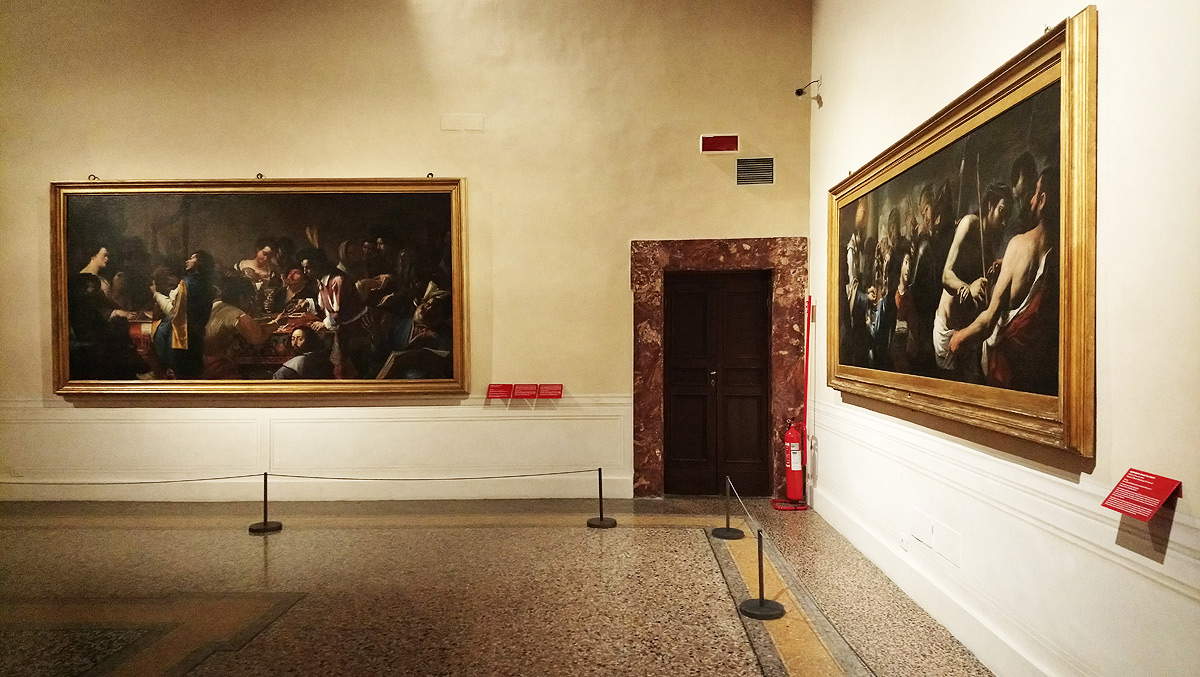 |
| Image from the exhibition The Triumph of the Senses. New light on Mattia and Gregorio Preti. Ph. Credit Finestre Sull’Arte |
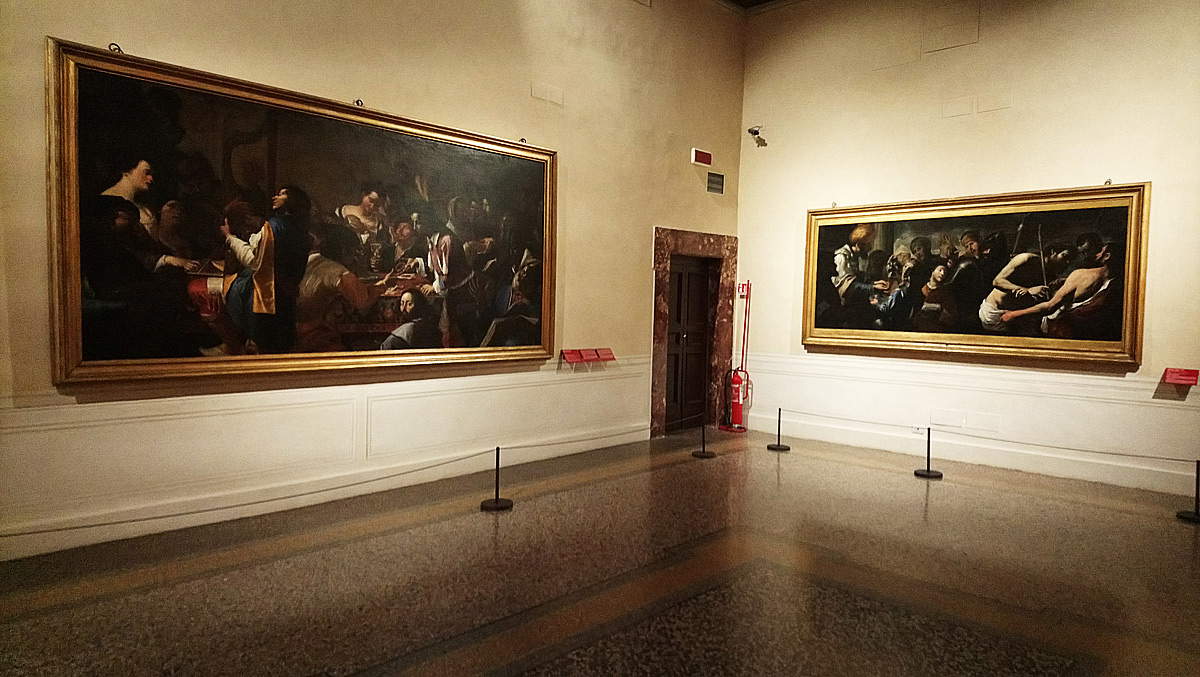 |
| Image from the exhibition The Triumph of the Senses. New light on Mattia and Gregorio Preti. Ph. Credit Finestre Sull’Arte |
 |
| Image from the exhibition The Triumph of the Senses. New light on Mattia and Gregorio Preti. Ph. Credit Finestre Sull’Arte |
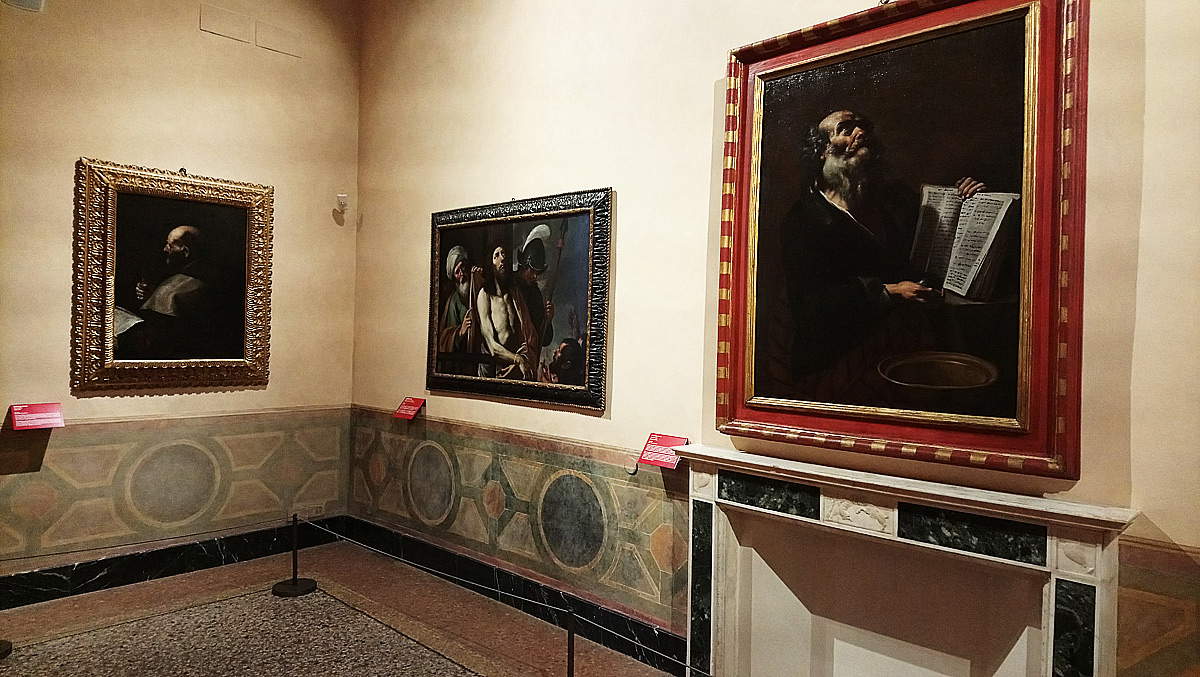 |
| Image from the exhibition The Triumph of the Senses. New light on Mattia and Gregorio Preti. Ph. Credit Finestre Sull’Arte |
The itinerary can begin with the Concert with Scene of Good Fortune preserved at the Albertina Academy in Turin, one of the paintings that, along with theAllegory of the Five Senses that is the great protagonist of the Palazzo Barberini exhibition, is part of that group of paintings "where the possibility of a collaboration between the two brothers or the attribution in toto to Gregorio or Mattia is still a matter of debate.", Tommaso Borgogelli writes in the catalog in his essay on Gregorio’s activity, “but from which transpires an artistic association based on entrepreneurial principles, within which Gregorio, at least in the early days, had to play a role of true guide rather than of master; of ’procurer of orders’ for himself and for his young brother by initiating the latter into the sphere of Roman workshops and collectors up to the most powerful families of the city.” In this large-format canvas (it reaches almost three meters wide), which came to the Albertina in 1830 with the legacy of Marquis Lodovico Pallavicini Mossi di Morano (moreover, at the time the work was curiously referred to Caravaggio), twelve characters, divided into three groups, are gathered in a tavern and are engaged in various activities: in the group on the left we witness an episode of “good fortune” typical of genre scenes of the early 17th century (a gypsy girl reads the hand of a young man as rich as he is naive, while two soldiers observe the scene and a child, probably the girl’s brother, as is typical of scenes of good fortune rummages in the pockets of the duped to rob him), in the center are a young violinist, the innkeeper lifting a jug of white wine, and a man with his head resting on his left hand, while on the right a laurel-crowned poet accompanies a spinet player with his zither, and a cook observes them preparing a bird on a spit. Around the painting, defined by Yuri Primarosa as “a sort of incunabulum of Mattia Preti’s painting in the workshop of his brother Gregorio,” there have been alternating positions over time of those who considered it the work of Mattia alone, those who considered it the work of Gregorio alone, and finally (this is the most recent theory) a fruit of collaboration between the two, a hypothesis reiterated on this occasion by the young curator who identifies Mattia’s hand in the figures of the poet (for whom, moreover, Primarosa proposes an identification with the poet Giovanni Battista Marino: a sort of tribute that would help provide the painting with a profound poetic meaning, in reference toAdonis and the five senses that constitute the five stages of Adonis’s, and man’s, journey toward knowledge), the character intent on preparing the spit, the accomplice of the gypsy girl, and the bearded old man. A complex painting, therefore, as much in content as in form: nevertheless, the difference in quality between the characters just listed and the others (compared to which the figures that can be assigned to Mattia appear less stereotyped and less rigid), though not as marked as in later realizations, would suggest that the painting was made by the two brothers together, in all likelihood in the first lustre of the 1930s.
Closely related to the Concert is theAllegory of the Five Senses, a later work (in the exhibition it is dated to 1642-1646, due to stylistic comparison with other works: here the composition appears more mature and complex than in other earlier works) and the subject of a restoration that provided the occasion for the preparation of the Roman exhibition. It is another large-format painting (it exceeds three and a half meters in width) and is still set in a tavern, although this time the scene is decidedly more populated (there are twenty characters) and animated: in an inventory, drawn up in 1686, of Prince Barberini’s possessions (the work has always been in the family collections since 1672, although it is not known whether the Barberinis were the first owners), the painting is described as “un quadro per longo con diversi retratti: chi sona, chi canta, chi gioca, chi beve e chi gabba il compagno, lungo palmi 14 e alto palmi 8 circa [.... by] the hand of Mattia Calabrese.” Again, the figures are arranged in groups, although united in a less paratactic manner than in the Turin painting: on the left, a first group consists of players delighting in various musical instruments (allegory of hearing), alongside we observe a man smoking a pipe (sense of smell) and a group of characters drinking (taste), while on the right we see a further scene of hand-reading (touch), and finally, in the foreground, we see Gregorio Preti’s self-portrait, which alludes to the sense of sight. In addition, on the right, the figures of Heraclitus and Democritus contribute to provide a philosophical context to the painted allegory (Democritus’ hand, with its five fingers in clear view, would leave no doubt). If the work was traditionally ascribed to the hand of Mattia alone, the investigations carried out during the recent restoration have made it possible to ascertain, on the contrary, the presence of two personalities in the same painting, and thus to confirm the hypothesis first formulated by Maurizio Marini in 2003. This is a painting executed by four hands, and the analyses conducted during the restoration have given us back several pieces of information about how the two brothers worked at the time: the intervention revealed the presence of numerous repentances and repaintings during the course of the work (the most conspicuous repainting concerns Gregorio Preti’s face, which initially showed far more mature somatic traits than those that can be appreciated on the finished canvas), indicating that the two brothers experimented continuously on the canvas itself, at most making use of sketchy preparations (a characteristic that, at least in this work, led them to opt for a dark background, much easier than a background with a painted environment, which would have required significantly more study), and working extensively on the arrangement of characters and objects (which changed often as the two worked on the painting) to ensure a sense of depth. In addition, the cleaning operation that removed the later repainting, which was guilty of giving an almost homogeneous quality to all areas of the work, thus altering the correct legibility, improved the situation by allowing a more certain attribution of the various portions of the canvas to the two artists. Primarosa ascribes to Gregory’s hand his self-portrait and the figures in the center (the man with the long pipe, although his hand is assigned to the younger Preti, the woman pouring him a drink, the two figures behind him, and the man playing cards on the right), while to Mattia most of the lateral portions (however, the figure of the harpist at least in part, and some minor interventions, are perhaps owed to his older brother, according to the curator). Finally, the two probably collaborated in the making of the philosophers.
The references in these paintings of the 1930s and 1940s range from the naturalism of Ribera (who likewise had ventured into genre scenes with allegorical representations of the five senses) to Guercino and Lanfranco, punctually taken up in the 1940s (theAllegory of Palazzo Barberini, Primarosa writes, can "be placed in the groove of the ’baroque’ production of Guercino’s and Lanfranco’s ambit, which the two artists remodeled in a minor tone drawing inspiration from illustrious Veronese prototypes and - especially Gregorio - from some petit-maîtres active at that time on the Capitoline scene," starting with Angelo Caroselli. Moreover, as anticipated, Gianni Papi also identifies points of contact with the painting of Orazio Riminaldi (in particular, for the Albertina canvas, the physiognomies elaborated by Gregory would represent an echo of those of Riminaldi, though not reaching the quality of the latter).
The first room of the exhibition concludes with a well-known work, Pilate Washing His Hands (where the usual qualitative differences suggest that it is a painting executed by the brothers at the same time), and especially with a remarkable unpublished work, a Christ and the Canaanite woman to be attributed to Mattia Preti according to Primarosa. The painting recounts the Gospel episode in which a woman asks Jesus to heal her demon-possessed daughter: the Canaanite woman is depicted at the feet of Christ, in a supplicating attitude, with a large group of people witnessing the scene, including the apostles accompanying their master. According to the curator, this is a work datable to 1646-1647, a period proposed on the basis of comparisons with coeval works, and a period in which Mattia reshaped his own Caravaggesque ascendancy by rethinking his painting in the wake of the recent innovations introduced by the beginnings of the Baroque with Guercino and Lanfranco, but not only. In particular, the neo-Venetian tone of the scene, setting and certain details (such as the veil of the Canaanite woman) harkens back to the years when the Calabrian painter sojourned in Venice, and is close to that of other famous paintings by Mattia Preti made in the mid-1940s. As for the painting’s role in Mattia Preti’s career, Primarosa believes that it is a prototype for other paintings that would have dealt with the same subject and that the artist would have made at different later moments of his career, while for the problem of the work’s provenance, a solution is proposed that refers to a possible commission by the Colonna family: there is no certain evidence, but according to the curator the presence of the column fragment in the lower left corner, the fact that Marcantonio V Colonna was among the best patrons of the Preti brothers at the time, and the documented circumstance of the prince’s purchase of three unidentified paintings between July 1647 and March 1654 would be three clues that could lead to this conclusion. However, the painting is attested in the Colonna collection for the first time only in 1783: a presence of it in the family collections ab origine is entirely plausible, and we have reason to believe that surely the question will be further investigated.
 |
| Gregorio and Mattia Preti, Concerto con scena di buona ventura (1630-1635; oil on canvas, 195 x 285 cm; Turin, Pinacoteca dell’Accademia Albertina) |
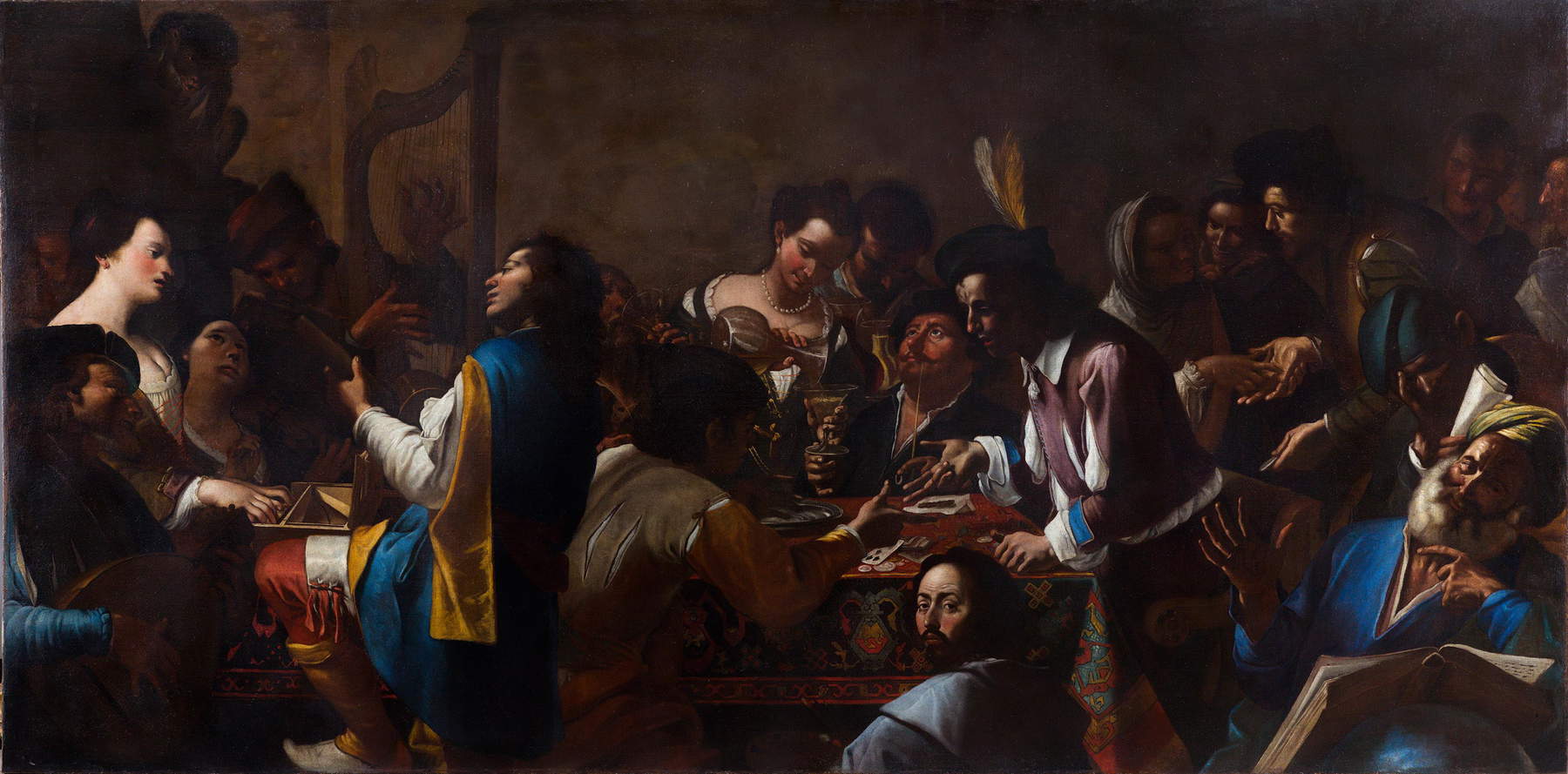 |
| Gregorio and Mattia Preti, Allegory of the Five Senses (c. 1642-1646; oil on canvas, 174.5 x 363 cm; Rome, Gallerie Nazionali di Arte Antica, Palazzo Barberini) |
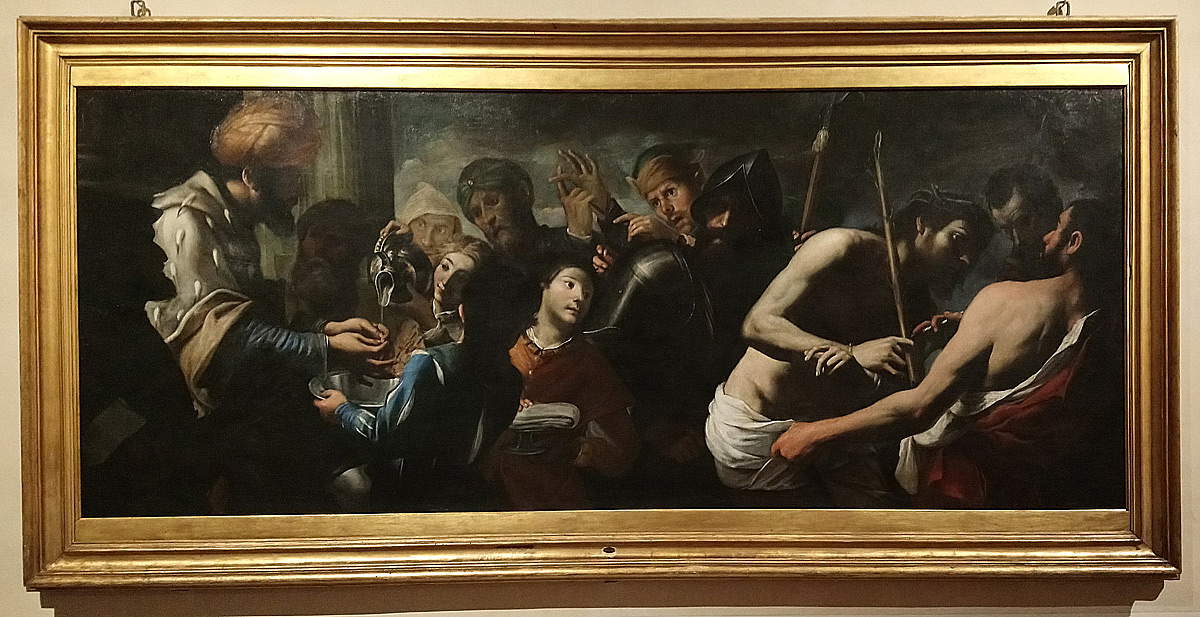 |
| Gregorio and Mattia Preti, Pilate Washes His Hands (c. 1640; oil on canvas, 131 x 295 cm; Rome, Rospigliosi Collection at Coldiretti Headquarters) |
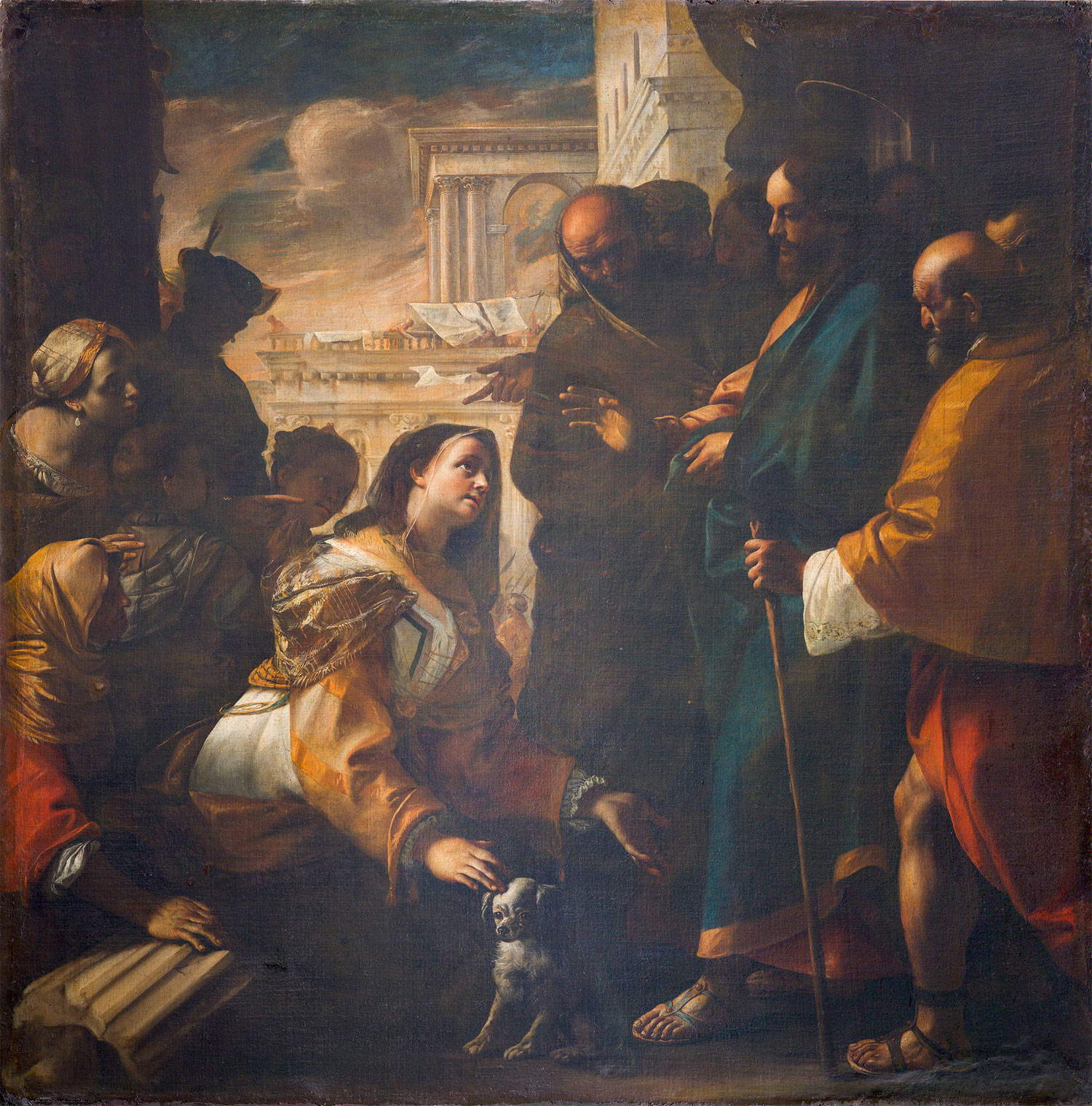 |
| Mattia Preti, Christ and the Canaanite Woman (c. 1646-1647; oil on canvas, 240 x 235 cm; Private collection) |
In the second room, we continue for a moment on the theme of Gregorio and Mattia’s collaboration with Christ Healing the Hydropic from the Lampertico Gallery in Milan (this work can be dated to the mid-1930s and in the exhibition is probably the one where the debts to Ribera’s art are most evident: according to Riccardo Lattuada, who was in charge of the work’s file in the catalog, Mattia should be credited with the composition and some contribution in the drafting of the figures, and Gregorio with “the more mechanical and objective execution of many details, such as the hands of all the figures and a greater hardness in the four faces on the left”), to introduce the autonomous beginnings of Mattia’s career with the exhibition of significant works, including the well-known Negation of Peter, from which the itinerary can begin. It is in fact a long-studied work (it became part of the collections of the National Gallery of Ancient Art as early as the late 19th century), although its original provenance is unknown: the language is undoubtedly Caravaggesque (and in particular Riberesque), nevertheless “mediated by clear references to Guercino and Lanfranco, highlighted by the use of light and color choices and also well evidenced by nineteenth-century attributions” (so Alessandro Cosma in the catalog), and with echoes from other sources as well (Rossella Vodret has noted that the left hand of St. Peter is a citation of the hand of the apostle we observe in Annibale Carracci’sAssumption at the Cerasi Chapel in Santa Maria del Popolo) has led critics to date the work to the mid-1930s and thus to identify in this painting one of the earliest evidences of Mattia Preti’s independent career, capable here of giving life to a theatrical language, strongly gesture-oriented, able to break away from the flatter and simpler solutions devised by Gregory. An unpublished Apostle, which appeared on the Portuguese antiquarian market in late 2018 and was immediately attributed by Keith Sciberras to the Taverna painter, should then belong to the same period (on these pages, we reported it among the must-see works at the 2018 edition of Flashback, where it was presented shortly after its purchase by Giamblanco Gallery). Another essay in adherence to Ribera’s modes, the work according to the curator "constitutes one of the earliest and happiest revivals of Caravaggio’s language by the young Mattia, who recovered the Merisian types of St. Peter, St. Jerome and St. Matthew in the light of the famous Apostolates painted in Rome by Ribera." The attribution also rests on the fact that the figure of this apostle is almost entirely superimposable with that of the St. Peter who appears in the other unpublished work in the Roman exhibition, Christ and the Canaanite woman.
We then move on to another long-studied work, the Escape from Troy from the Palazzo Barberini collections, to delve deeper into the Mattia Preti of the 1940s, a period to which, in this painting, the open setting on a sky furrowed by reddish clouds typical of this phase of his production refers. The scene, one of the most famous of theAeneid, is resolved with monumental accents enhanced by certain details (such as the step, which looks almost like the base of a statue), by the similarities with Bernini’sAeneas and Anchises, to which the painting has been repeatedly compared, and by the strong chiaroscuro contrasts, of Guercino influence, that delineate the two main figures, that of Aeneas, who is leaning on his spear, and that of his father Anchises, carried by him on his shoulder. This is counterbalanced by the lively dynamism of his young son Ascanius, who sprints ahead of the figures of his father and grandfather. So if the Escape from Troy represents an example of how much Mattia Preti’s art owes to that of Guercino, the small Head of a Little Girl with Coral Necklace recalls the art of Lanfranco: it is a work that re-emerged from the deposits of Palazzo Barberini on the very occasion of the exhibition, and was here for the first time assigned to Mattia Preti by the curator. The only two previous proposals for attribution (to the circle of Giovan Gioseffo Dal Sole and to Antonio de Bellis) had been conditioned by the state of preservation of the canvas, covered by dirt and oxide from the varnishes: the restoration conducted on the occasion of the exhibition has restored the painting to its legibility, allowing us to appreciate the strong luminism with the clear division of areas in light and those in shadow, obtained, however, with “a skilful modulation of brown tones” (Primarosa) that can be compared to the manner of Mattia Preti of the mid-1940s. Not much is known about this work depicting a little girl with the coral beads around her neck, which were typically used apotropaically to protect infants: it was probably a study for a larger work, and has been related here to the spinet player in theAllegory of the Five Senses (although this is probably little more than a suggestion). But it is also likely that it was a portrait useful for composing a repertoire that the artist would later use in larger later compositions: this was a habit for the Calabrian artist.
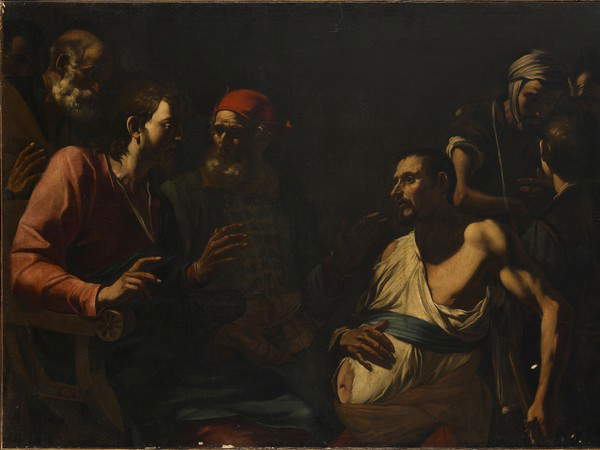 |
| Gregorio and Mattia Preti, Christ Heals the Hydropic (c. 1635; oil on canvas, 122 x 180 cm; Milan, private collection, courtesy Matteo Lampertico) |
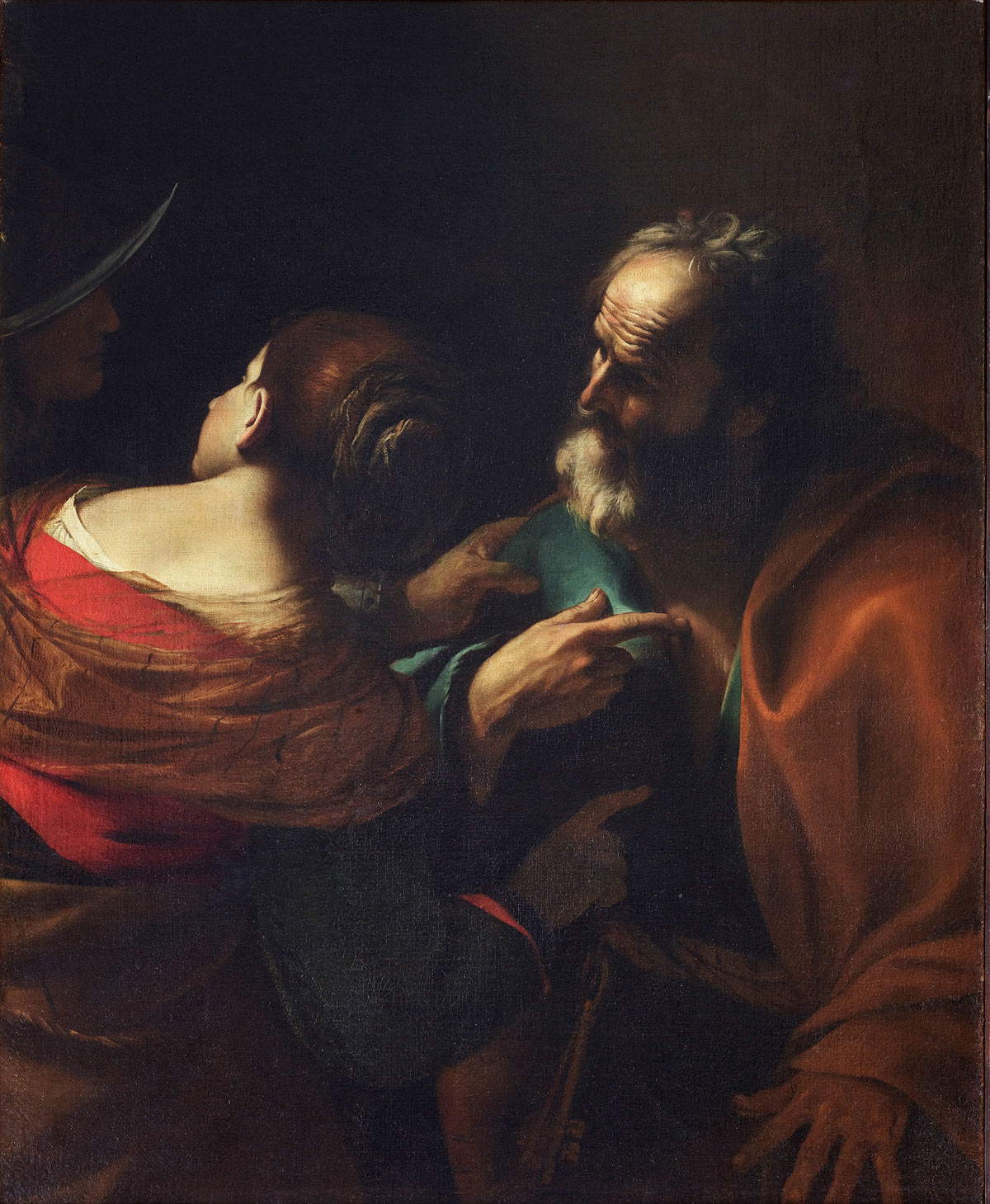 |
| Mattia Preti, Denial of Peter (c. 1635; oil on canvas, 126 x 97 cm; Rome, Gallerie Nazionale d’Arte Antica, Palazzo Barberini) |
 |
| Mattia Preti, Apostle (c. 1635; oil on canvas, 97 x 73.5 cm; Turin, Galleria Giamblanco) |
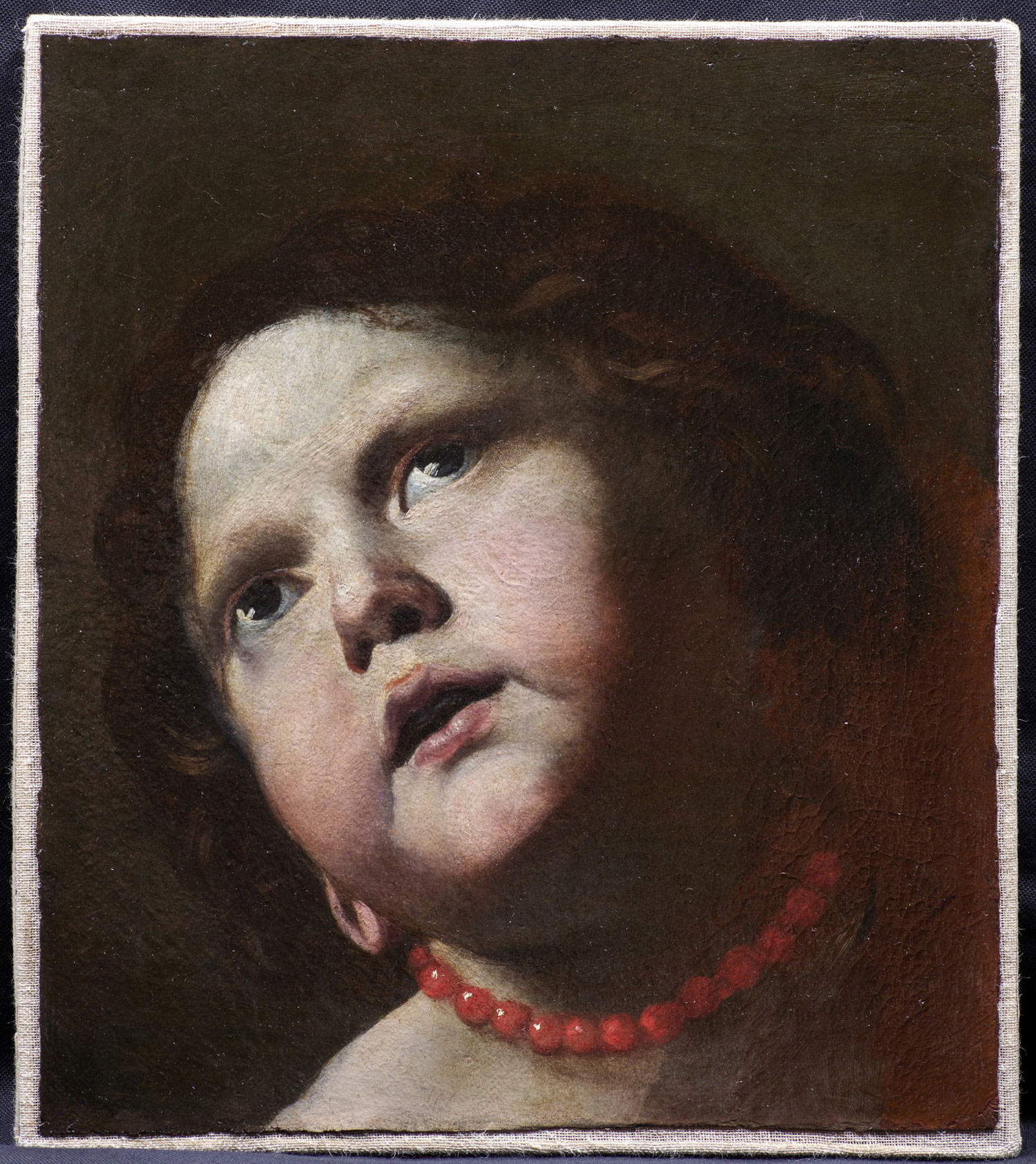 |
| Mattia Preti, Head of Girl with Coral Necklace (1645-1650; oil on canvas, 32 x 28.5 cm; Rome, Gallerie Nazionale d’Arte Antica, Galleria Corsini) |
The size of the Palazzo Barberini exhibition (twelve paintings on display in all) does not prevent us from describing it as one of the most important of this year, for the various achievements, for the publication of important unpublished works, for the amount of material that is provided to scholars of early seventeenth-century Rome, and for the quality of the itinerary and the works presented. In addition (a detail of no small importance and which, indeed, in our opinion should be well emphasized), this review was born from the research of a young scholar (if not very young, given the anagraphic standards to which we are unfortunately accostumed in Italy), who should be congratulated for having been able to put together a mature and high-level exhibition: the hope is that Il trionfo dei sensi. New Light on Mattia and Gregorio Preti also succeeds in demonstrating the urgent need to invest in a field where generational turnover is often absent and where so many young scholars struggle to establish themselves due to lack of opportunity resulting from scarcity of resources and investment.
The objective stated in the title of the exhibition has thus been achieved: it is the case to say that “new light” has indeed been shed on an important painting that contributes to defining the early years of the Roman activity of the Preti brothers (in particular, it is worth noting how the restoration and diagnostic investigations, which have given an account of all the changes undergone by the painting during its course, have contributed to providing important information on Gregorio and Mattia Preti’s way of working). The comparison with the Albertina’s Concerto is remarkable (this is the first time the two works are exhibited in the same venue: visitors will find them facing each other, on two opposite walls), the construction of the itinerary is skilful, which first introduces us to the collaborative paintings and then goes into the merits of the works executed by Gregorio and Mattia separately, and the information apparatuses are punctual (each of the two rooms has detailed summary panels, and each work is flanked by a caption summarizing its contents). Cosma and Primarosa’s intelligence also lies in having lightened (in an obviously positive sense) for the public a research exhibition that, on paper, could be said to be reserved for an audience of scholars or at most enthusiasts: this is not the case, also because its inclusion in the Palazzo Barberini itinerary leads the general public to perceive it almost as a focus on the seventeenth century, an in-depth look at what will be seen by continuing the visit in the immediately adjoining rooms, a way to broaden the vision on the context (this is not a feeling of the writer: it is the recording of the reactions of the public at the time we visited the exhibition). The exhibition is completed by a rich catalog where, in addition to the fundamental essays mentioned here (Papi’s on Mattia Preti’s youth, Borgogelli’s contribution, Primarosa’s two in-depth essays on theAllegory and on Christ and the Canaanite woman) and extensive worksheets , appear a detailed report by Mantella and Guido on the restoration and its results, and an in-depth study by Francesca Curti on the works of the two brother painters in the Angelelli and Vallone collections, important in that it offers further insights into the commissioning and collecting of the two in the seventeenth century.
Warning: the translation into English of the original Italian article was created using automatic tools. We undertake to review all articles, but we do not guarantee the total absence of inaccuracies in the translation due to the program. You can find the original by clicking on the ITA button. If you find any mistake,please contact us.